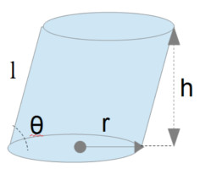The Volume of a Slanted Cylinder calculator computes the volume of a slanted cylinder as a function of the radius, side length and slant angle (see diagram):
INSTRUCTIONS: Choose units and enter the following:
- (r) base radius,
- (l) side length and
- (θ) slant angle
Volume of the Slanted Cylinder (V): The calculator returns the volume in cubic meters. However this can be automatically converted to other volume units via the pull-down menu. If the slant angle (θ) and side length (l) are unknown, but the height (h) is, the following formula will compute the volume CLICK HERE -Cylinder Volume.
The Math/ Science
The formula for the volume of a slanted cylinder is:
`V = π⋅r^2⋅l⋅sin(θ)`
where:
- V = volume of the slanted cylinder
- r = radius of base
- l = slanted side length
Slanted Cylinder Calculators
- Surface Area of a slanted cylinder based on the radius (r) and side length (l).
- Surface Area of a slanted cylinder based on the radius (r), slant angle (θ) and the height (h).
- Volume of a Slanted Cylinder
- Mass or Weight of a Slanted Cylinder

Cylinder Calculators
- Cylinder Side Area: Computes the surface area of the sides of a cylinder based on height and radius.

- Cylinder Surface Area: Computes the total surface area of a cylinder including sides, top and bottom.
- Cylinder Volume: Computes the volume of a cylinder based on cylinder height and radius.
- Cylinder Volume from Height and Circumference: Computes the volume of a cylinder based on the height and circumference. It also returns the diameter of the cylinder.
- Cylinder Height: Computes the height of a cylinder based on the volume and radius.
- Cylinder Radius: Computes the radius and diameter of a cylinder based on the volume and height.
- Cylinder Weight: Computes the weight, mass and volume of a cylinder based on the height, radius and density.
- Cylinder Mass Computes the mass of a cylinder based on the radius and height and mean density of the cylinder.
- Volume in Horizontal Cylinder: Computes partial volume of a horizontal circular cylinder based on the radius and length of the cylinder and the vertical height of the contents in the cylinder (see diagram).
- Cylinder Density: Computes the mean density of a cylinder based on the mass and computed volume from the radius and height.
- Slanted Cylinder Surface Area: Computes the surface area of a slanted cylinder based on the radius and side length (L).
- Slanted Cylinder Area from Angle: Computes the lateral area (surface area of the sides) of a slanted cylinder based on its radius, height and slant angle (θ).
- Slanted Cylinder Volume: Computes the volume of a slanted cylinder based on the radius of the base, side length and slant angle.
- Slanted Cylinder Weight: Computes the weight or mass of a slanted cylinder based on the radius, side length, slant angle and density.
- Cylinder MoI about Central Axis: Computes the moment of inertia of a cylinder about its central axis based on the mass and radius.
- Cylinder MoI about the End: Computes the moment of inertia of a solid circular cylinder of uniform density about an axis along the diameter of the cylinder at one end.
- Cylinder MoI Perpendicular to Axis: Computes the moment of inertia of a solid circular cylinder of uniform density about an axis perpendicular to the axis of the cylinder and through the center of mass.
Volume is a three dimensional measurement of the amount of space taken up by an object. Volume units are cubic measurements for solid objects such as cubic inches and cubic meters. Fluids have separate volume units such as liters, fluid ounces, cups, gallons, and barrel.
The volume of an object can measured by the liquid it displaces or be calculated by measuring its dimensions and applying those dimensions to a formula describing its shape. Many such calculations are available in the following list of calculators.
In many cases, the calculators are for a column with a geometric shaped base and vertical sides. One basic formula for volume is area times a Height when the volume has vertical sides.

Volume Calculators
- Volume from Area and Height
- Volume of a Cube
- Volume of a Box
- Volume of a Cone
- Volume of a Cone Frustum
- Volume of a Cylinder
- Volume of a Slanted Cylinder
- Volume of a Semicircle
- Volume of a Triangular
- Volume of a Quadrilateral
- Volume of a Pentagon
- Volume of a Hexagon
- Volume of a Heptagon
- Volume of a Octagon
- Volume of a Nonagon
- Volume of a Decagon
- Volume of a Hendecagon
- Volume of a Dodecagon
- Volume of a Paraboloid
- Volume of a Polygon based Pyramid
- Volume of a Pyramid Frustum
- Volume of a Sphere
- Volume of a Sphere Cap
- Volume of a Sphere Segment
- Volume of a Sphere Shell
- Volume of a Oblate Spheroid
- Volume of a Ellipsoid
- Volume of a Torus
- Volume of a Bottle
- Volume of a Chamfer
- Gasket Volume